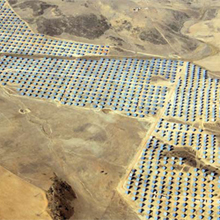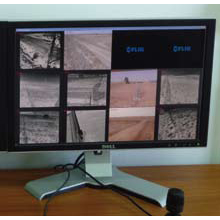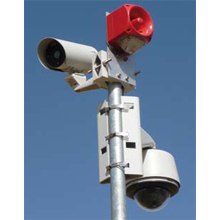 |
| 27 FLIR thermal imaging cameras have been installed to protect the 9 kilometres long perimeter |
The last year’s environmental awareness has increased drastically. Instead of relying on fossil or nuclear energy only for generating electricity, renewable energies have come into play. It is generated from natural resources such as wind, water, tides, geothermal heat and solar energy. One of the main solar plants in Spain is the Abertura Solar Park. It represents an investment of over 225 Million Euro. FLIR Systems thermal imaging cameras are protecting this investment day and night. To protect the 9 kilometre long perimeter, 27 FLIR Systems thermal imaging cameras have been installed.
With the help of photovoltaic cells, commonly called solar panels, light can be converted to electricity. Although Germany and Japan have long led the field in solar thermal energy production, today Spain is the hub for solar energy activity.
Abertura photovoltaic solar plant
One of the main sites in Spain is the plant of Abertura. The Abertura Solar Park is located in the Spanish province of Cáceres. The location is considered ideal because it gets almost 2,000 net hours of sun per year and the land is very flat which is ideally suitable to installing photovoltaic solar panels.
The 23.1 Mega Watt peak (MWp) Abertura Solar project, employing dual-axis solar trackers, is the largest project in the world using this technology. The solar trackers make the panels move both north – south and west - east. They assure that the solar panels are always in the ideal position to the sun which drastically increases the plant’s capacity. Abertura Solar uses more than two hundred 115 kilo Watt peak (kWp) installations. It was completed in July 2008. The entire installation covers an area of more than 2,000,000 square meters.
Vector Cuatro: Installing and managing solar plants
Vector Cuatro is the leading company in Spain for strategic and financial consulting on investments in solar photovoltaic power plants. Currently, Vector Cuatro manages and/or administers nearly 90 MW. It is the only management and administration company that has participated in the complete process of promotion, development, structuring, financing and start up of photovoltaic installations for third parties.
Today, Vector Cuatro manages 13 solar power plants in Spain. For nine of these plants the management started after the plants had been constructed. The solar plant in Abertura, was entirely developed and constructed under the supervision of Vector Cuatro.
IBERDROLA: Transport and distribution of electricity generated at Abertura
 |
| FLIR Sensors Manager software allows for easy installing and managing thermal imaging cameras and other sensors in a TCP/IP network |
Just as in any power station, the energy generated by the photovoltaic cells is being inverted from DC to AC. Each of the two thousand trackers generates 11.5 kWp at 400 V DC. Once the 400 V DC is inverted to 400 V AC, a step-up transformer increases the voltage to 20 kV in order to transport the electrical energy. Finally, the energy generated is uploaded to the distribution grid of the local utility at 45 kV.
At Abertura, the utility that is uploading the electricity to its grid and distributing it is GRUPO IBERDROLA. Following a period of strong international expansion, IBERDROLA has established itself as one of the four largest energy companies in the world by market capitalisation. Grupo IBERDROLA has made a major commitment to the use of cleaner technologies, becoming a world leader in solar and wind energy. It is one of the companies with the lowest CO2 emission levels in the electricity sector.
The Iberdrola Ingeniería Substations Department also designed and built the transformer substation at Abertura.
225 Million Euro facility security
“The development and construction of the Abertura solar power plant has been a giant project.” explains Mr. Borja Escalada, Managing Partner of the Vector Cuatro Group. “We were involved in every step. Acquiring the land on which the plant is installed, purchasing and installing the photovoltaic cells and solar trackers, and all other aspects. The entire solar plant represents a total investment of approx. 225 Million Euro. Depending on the climatic conditions, we generate electricity for about 25 Million each year.”
“It is clear that an investment of 225 Million Euro needs to be protected. There are several threats for an installation of this size. Photovoltaic panels are expensive. Therefore theft is a big concern. We also have a huge network of copper cables. Therefore the site needs to be protected against copper theft as well.”
“The site not only needs to be protected against theft. We need to protect potential thieves and other intruders against themselves as well. The site contains quite some high voltage installations. People that are gaining unauthorised might hurt themselves seriously or even worse, get killed.” continues Mr. Escalada.
“Also for IBERDROLA it is important that the plant is well protected.” says Miss Esther Muñoz , Technical Maintenance of IBERDROLA Ingeniería Y Construcción. “Power generating facilities are vital for a countries economy and are a potential target for terrorism. If anything should happen to the plant due to sabotage or terrorism we would lose a part of our grid so that we can not serve our customers. This needs to be avoided at all times.”
Securing the 9 kilometre long perimeter
 |
| An observation post consists of a fixed mounted FLIR thermal imaging camera, light/sound beacon and in some cases a CCTV camera |
“Securing a perimeter of almost 9 kilometres is however not an easy task.” says Mr. Escalada. “During daytime we are not too worried since we have a maintenance crew of 4 or 5 people that is constantly walking around on the site. Security at night however, is a different issue.”
“Although we have experience with this in the other solar plants we are managing, Abertura was the first plant at which we could decide ourselves what would be the best security option. The other plants are managed by Vector Cuatro after the security system was decided and contracted”.
Comparing CCTV, fences, walking patrols and thermal imaging
“We looked at several possibilities. Conventional CCTV with lighting or infrared illuminators, walking patrols, passive IR barriers and thermal imaging cameras. After careful evaluation of each option, we have chosen for thermal imaging cameras for multiple reasons."
"The entire perimeter around the plant can not be lit up. This is far too intrusive for the area in which the solar plant is located. Installing and maintaining light is also an expensive exercise. It also uses a lot of power.”
“Infrared illuminators are also expensive. Furthermore, infrared illumination is not offering the same range performance as thermal imaging cameras at all. This means that more cameras need to be installed and more civil works need to be carried out.”
“Although we have a fence around the entire perimeter, this is not the best solution either. The fence is relatively weak since we need to have large holes in it so that animals can get through it. But even if the fence would be stronger, we would need to install detectors in it. In order to see if an alarm is false or not, a CCTV system with lights and infrared illuminators needs to be installed anyhow.”
“Finally we looked at patrolling the area. But apart from the fact that guards are a costly exercise, we defined another more unexpected problem. Abertura is a sandy location where a lot of dust can be produced. Patrolling the entire area means that the guards would need to drive around in a car during the night as well. By doing this they would produce a lot of dust. This seems to be not important, but it is. In order to keep the solar panels as effective as possible, we need to remove the dust from them. Now we do this twice a year. Each cleaning costs about 100, 000 Euro. We estimated that if we have the area patrolled during the night, we need one extra cleaning per year.”
FLIR thermal imaging cameras: Low Total Cost of Ownership
"FLIR Networked Systems, a separate division within FLIR Systems, provided us Mini Servers, input/output boxes, video processing units and Network Digital Video Recorders", says Esteban Ces, Owner, Soviter |
“I got in contact with Mr. Esteban Ces of Soviter, a FLIR Systems distributor in Spain. He explained me the concept of the thermal fence and the advantages of using a video analytics solution based on thermal imaging cameras. After a thorough calculation of installation cost, and even more important, of the Total Cost of Ownership, we decided to go for this option.”
“To protect the 9 kilometre perimeter we have installed 27 FLIR Systems thermal imaging cameras: two VSR-6, six SR-19, five SR-35 and twelve SR-50 are creating a thermal fence around the solar plant. Two FLIR Systems SR-100 thermal imaging cameras, mounted on a pan/tilt were installed separately as an addition to this thermal fence. Vector Cuatro also ordered two spare units that can be installed if something should go wrong with one of the thermal cameras. So far, there has been no need to use them.” explains Esteban Ces of Soviter.
FLIR Systems hardware and software
“We have chosen not only for FLIR Systems thermal imaging cameras, but a lot of the other material we needed is from FLIR Systems as well. FLIR Networked Systems, a separate division within FLIR Systems, provided us Mini Servers, input/output boxes, video processing units and Network Digital Video Recorders. The software used to manage the entire systems is FLIR Sensors Manager. This out-of-the-box software allows for easy installing and managing FLIR Systems thermal imaging cameras and other sensors in a TCP/IP network.”
The thermal fence
“The principle of the thermal fence is quite simple. All cameras are installed along the perimeter. Using the FLIR Sensors Manager software we define “trip wires”, a video analytics algorithm, to detect if someone is trying to intrude the perimeter. If someone crosses a line, which we have set in the video analytics, an alarm will go off. A light will start to flash and an acoustic alarm will go off as well. The operator will immediately see the image on his screen of the camera that has created the alarm. He can then determine if it is a false alarm, created by e.g. an animal or not. If it is a real alarm and the intruder is not scared away by the light and sound, the operator will call the police which can be on the scene within minutes.”
Combining FLIR thermal imaging cameras and video analytics
“Along the perimeter 25 observation posts are installed. An observation post consists of a fixed mounted FLIR Systems thermal imaging camera that is covering a certain part of the perimeter, a light/sound beacon and in some cases a CCTV camera that can eventually be used during daylight.”
“At each observation post an electrical cabinet is installed. The video and data of the thermal imaging camera and the CCTV camera are transferred to a FLIR Mini Server. The beacon is also connected to the FLIR Mini Server over a FLIR input/output (I/O) box. All signals are converted by the Mini Server to TCP/IP. Thanks to an Ethernet to fibre optics converter all signals are transferred over long distance to the control room. At this control room the data is put on a TCP/IP network again with fibre optics to Ethernet converter.”
"For future solar plants that still need to be constructed, we will definitely choose the same solution. And when the security system in existing solar plants needs to be replaced, it will be replaced by a thermal solution as well", says Borja Escalada, Managing Partner, Vector Cuatro Group |
“On the same Local Area Network (LAN) a computer is connected. It runs FLIR Sensors Manager and displays the images of the thermal cameras. It also allows setting the necessary rules for the alarms. These rules are sent to FLIR Systems Video Processing Units. They are constantly analysing the thermal images coming from the cameras. If they detect an anomaly, the Video Processing Units will send a signal to the observation post that is generating the alarm. The Mini Server will send a signal to the I/O box. A contact will close and a sound/light alarm will go off. At the same time the operator will get the image of the camera that provoked the alarm on his screen so that he can take the necessary action.”
“Finally, in the control room, FLIR Systems nDVRs are connected to the LAN. They are continuously recording all images of all thermal imaging cameras. They have the capacity to store all the images during 15 days. Afterwards they overwrite the data.”
“The combination of the FLIR Systems thermal imaging cameras and the video analytics all managed by FLIR Sensors Manager is perfect. During the night there is great thermal contrast between the environment and a potential intruder which means that we only need two or three pixels to detect something. This means that we can detect potential intruders at an extremely far distance away. In fact, thermal imaging cameras provide much more information to video analytics than CCTV cameras.”
Thermal imaging, the preferred solution
“We are extremely happy with the thermal fence.” says Mr. Escalada. “Not only is it a cost effective solution due to the fact that we did not need to do huge civil works and that we are not consuming a lot of electricity, it is very effective as well. If I compare this security installation with the ones we have at other solar plants we are managing, I can only say it beats them all. We have practically no false alarms and are able to protect the entire perimeter with just one operator.”
“For future solar plants that still need to be constructed, we will definitely choose the same solution. And when the security system in existing solar plants needs to be replaced, it will be replaced by a thermal solution as well.” concludes Mr. Escalada.


















